Pool House Considerations For Your Backyard
Imagine stepping into your backyard and being greeted by a luxurious pool house that not only complements your swimming pool but also enhances the overall aesthetic and functionality of your outdoor space. With more homeowners investing in their outdoor living areas, pool houses are becoming a popular addition to residential backyards. In this blog post, we'll explore everything you need to know about building a pool house—from design considerations to legal requirements. Whether you're looking for a chic relaxation spot or a practical extension of your home, we've got you covered.

Aesthetics and Functionality
When designing your pool house, it’s essential to strike a balance between aesthetics and functionality. A well-designed pool house should seamlessly blend with the existing architecture of your home and landscape, creating a cohesive look. Consider using materials and colours that complement your house and outdoor area. Additionally, think about the layout and how it will be used. For example, if you plan to entertain guests, include a spacious seating area and a small kitchenette. If relaxation is your priority, focus on creating a cosy lounge area with comfortable furniture.
Incorporating large windows or glass doors can also enhance the visual appeal of your pool house, allowing plenty of natural light to flood in and providing stunning views of your garden or pool. Don’t forget about lighting—both inside and outside. Proper lighting can set the mood and ensure safety, especially during evening gatherings.
Lastly, personal touches like decorative accents, artwork, and outdoor rugs can add character and make your pool house feel like an extension of your home. Remember, the goal is to create a space that’s not only beautiful but also functional and inviting.
Practical Elements
A well-thought-out pool house should cater to the practical needs of its users. Incorporating restrooms and changing spaces can significantly enhance the convenience of your pool area, eliminating the need for wet feet traipsing through your home. Opt for durable and water-resistant materials for floors and walls to withstand the humid environment.
Storage is another critical element. Consider built-in cabinets or shelves to store pool supplies, towels, and other essentials. If space allows, a small laundry area can be a lifesaver for washing swimwear and towels without needing to go indoors.
In addition, think about installing a small kitchenette with a fridge and sink. This way, you can easily prepare and serve refreshments during pool parties or family gatherings. By addressing these practical elements, you’ll ensure your pool house serves its purpose effectively and efficiently.
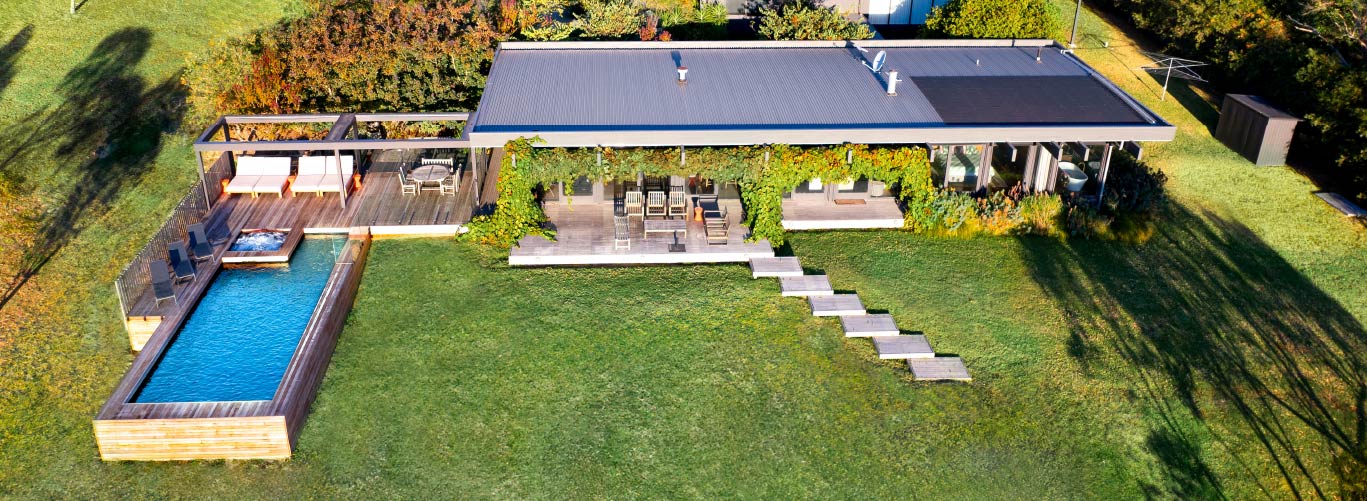
Energy Efficiency
Sustainability is an increasingly important consideration for homeowners. When constructing your pool house, there are several ways to incorporate energy-efficient practices. Start by choosing eco-friendly building materials, such as reclaimed wood or recycled metal, which have a lower environmental impact.
Next, consider installing energy-efficient windows and doors to improve insulation and reduce heating and cooling costs. Solar panels can also be a fantastic addition, providing a renewable energy source to power your pool house’s lighting and appliances.
Water conservation is another crucial aspect. Incorporate low-flow fixtures in restrooms and consider installing a rainwater harvesting system for irrigation purposes. By focusing on energy efficiency, you’ll not only reduce your carbon footprint but also save on utility bills in the long run.
Pool House vs. Cabana
Understanding the differences between a pool house and a cabana can help you decide which option best suits your needs. A pool house is typically a more substantial structure, often featuring amenities like restrooms, changing rooms, and sometimes even living spaces. It’s designed to be a multi-functional space that can be used year-round.
On the other hand, a cabana is usually a smaller, open-sided structure that’s primarily used for shade and relaxation. Cabanas may include seating areas and sometimes a small bar or kitchenette, but they generally lack the more extensive amenities of a pool house.
When deciding between the two, consider your budget, space, and how you plan to use the structure. If you require a versatile space that offers more than just a place to lounge, a pool house may be the better investment.
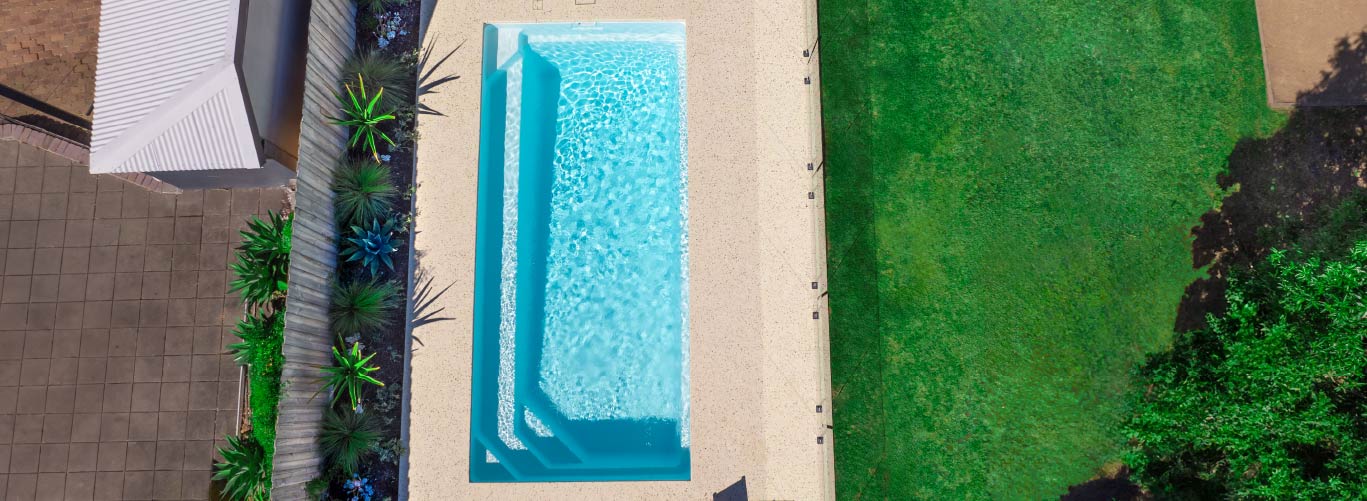
Legal and Safety Considerations
Before you start building your pool house, it’s essential to understand the legal and safety requirements in your area. Check with your local government regarding permits and zoning regulations. Some areas may have specific guidelines on the size, height, and placement of pool houses.
Safety is another crucial aspect. Ensure your pool house complies with local building codes, including electrical and plumbing standards. Installing smoke detectors, carbon monoxide alarms, and fire extinguishers can provide additional safety measures.
It’s also wise to consult with a professional contractor who can guide you through the legalities and ensure your pool house is built to code. By addressing these considerations upfront, you’ll avoid potential legal issues and ensure a safe and secure environment.
Maintenance and Landscaping
Keeping your pool house and surrounding area pristine requires regular maintenance and thoughtful landscaping. Clean the interior and exterior surfaces regularly to prevent dirt and grime buildup. Check for any signs of wear and tear, such as leaks or damage, and address them promptly to avoid costly repairs.
Landscaping plays a significant role in the overall appeal of your pool house. Choose plants and trees that complement the design and provide natural beauty. Consider installing pathways and lighting to create a welcoming and safe environment.
Additionally, think about how you can integrate your pool house with the rest of your backyard. Create a seamless transition with a patio or deck, and add outdoor furniture to extend your living space. By maintaining your pool house and landscaping, you’ll ensure it remains an attractive and enjoyable part of your home.
Conclusion
Building a pool house can elevate your backyard experience, providing a perfect blend of luxury and practicality. By considering design, functionality, sustainability, and legal requirements, you can create a space that enhances your lifestyle and adds value to your home.
We hope this guide has provided valuable insights and inspiration for your pool house project. Whether you’re in the planning stages or ready to start building, remember that a well-designed pool house can transform your backyard into a personal oasis.
Pool House Considerations For Your Backyard
Imagine stepping into your backyard and being greeted by a luxurious pool house that not only complements your swimming pool but also enhances the overall aesthetic and functionality of your outdoor space. With more homeowners investing in their outdoor living areas, pool houses are becoming a popular addition to residential backyards. In this blog post, we'll explore everything you need to know about building a pool house—from design considerations to legal requirements. Whether you're looking for a chic relaxation spot or a practical extension of your home, we've got you covered.
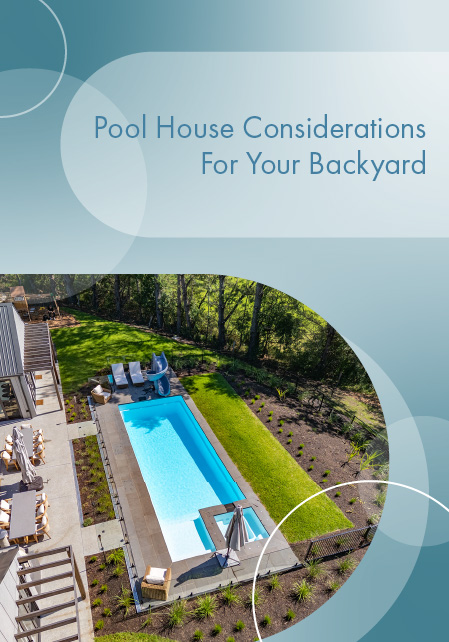
Aesthetics and Functionality
When designing your pool house, it’s essential to strike a balance between aesthetics and functionality. A well-designed pool house should seamlessly blend with the existing architecture of your home and landscape, creating a cohesive look. Consider using materials and colours that complement your house and outdoor area. Additionally, think about the layout and how it will be used. For example, if you plan to entertain guests, include a spacious seating area and a small kitchenette. If relaxation is your priority, focus on creating a cosy lounge area with comfortable furniture.
Incorporating large windows or glass doors can also enhance the visual appeal of your pool house, allowing plenty of natural light to flood in and providing stunning views of your garden or pool. Don’t forget about lighting—both inside and outside. Proper lighting can set the mood and ensure safety, especially during evening gatherings.
Lastly, personal touches like decorative accents, artwork, and outdoor rugs can add character and make your pool house feel like an extension of your home. Remember, the goal is to create a space that’s not only beautiful but also functional and inviting.
Practical Elements
A well-thought-out pool house should cater to the practical needs of its users. Incorporating restrooms and changing spaces can significantly enhance the convenience of your pool area, eliminating the need for wet feet traipsing through your home. Opt for durable and water-resistant materials for floors and walls to withstand the humid environment.
Storage is another critical element. Consider built-in cabinets or shelves to store pool supplies, towels, and other essentials. If space allows, a small laundry area can be a lifesaver for washing swimwear and towels without needing to go indoors.
In addition, think about installing a small kitchenette with a fridge and sink. This way, you can easily prepare and serve refreshments during pool parties or family gatherings. By addressing these practical elements, you’ll ensure your pool house serves its purpose effectively and efficiently.
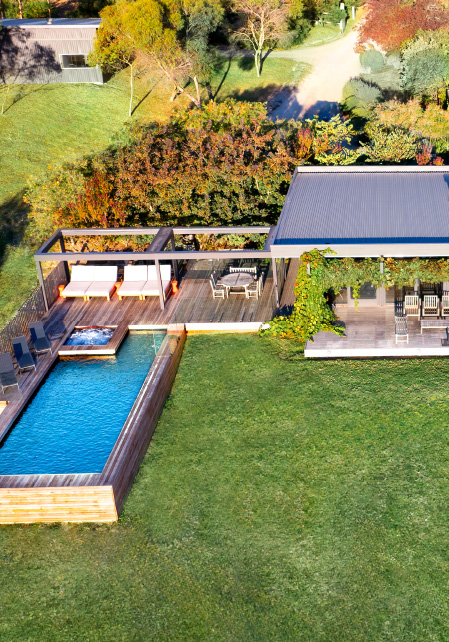
Energy Efficiency
Sustainability is an increasingly important consideration for homeowners. When constructing your pool house, there are several ways to incorporate energy-efficient practices. Start by choosing eco-friendly building materials, such as reclaimed wood or recycled metal, which have a lower environmental impact.
Next, consider installing energy-efficient windows and doors to improve insulation and reduce heating and cooling costs. Solar panels can also be a fantastic addition, providing a renewable energy source to power your pool house’s lighting and appliances.
Water conservation is another crucial aspect. Incorporate low-flow fixtures in restrooms and consider installing a rainwater harvesting system for irrigation purposes. By focusing on energy efficiency, you’ll not only reduce your carbon footprint but also save on utility bills in the long run.
Pool House vs. Cabana
Understanding the differences between a pool house and a cabana can help you decide which option best suits your needs. A pool house is typically a more substantial structure, often featuring amenities like restrooms, changing rooms, and sometimes even living spaces. It’s designed to be a multi-functional space that can be used year-round.
On the other hand, a cabana is usually a smaller, open-sided structure that’s primarily used for shade and relaxation. Cabanas may include seating areas and sometimes a small bar or kitchenette, but they generally lack the more extensive amenities of a pool house.
When deciding between the two, consider your budget, space, and how you plan to use the structure. If you require a versatile space that offers more than just a place to lounge, a pool house may be the better investment.
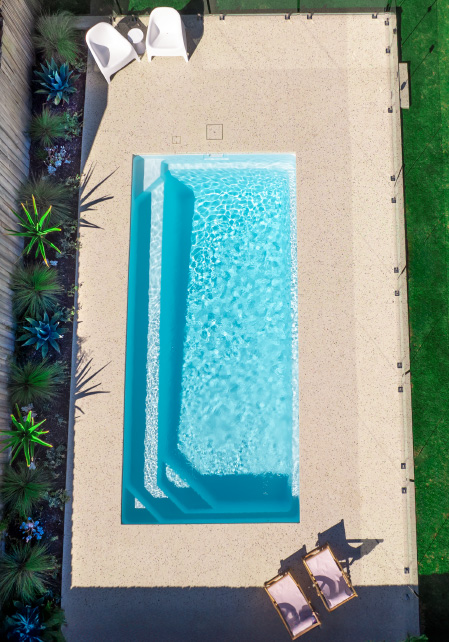
Legal and Safety Considerations
Before you start building your pool house, it’s essential to understand the legal and safety requirements in your area. Check with your local government regarding permits and zoning regulations. Some areas may have specific guidelines on the size, height, and placement of pool houses.
Safety is another crucial aspect. Ensure your pool house complies with local building codes, including electrical and plumbing standards. Installing smoke detectors, carbon monoxide alarms, and fire extinguishers can provide additional safety measures.
It’s also wise to consult with a professional contractor who can guide you through the legalities and ensure your pool house is built to code. By addressing these considerations upfront, you’ll avoid potential legal issues and ensure a safe and secure environment.
Maintenance and Landscaping
Keeping your pool house and surrounding area pristine requires regular maintenance and thoughtful landscaping. Clean the interior and exterior surfaces regularly to prevent dirt and grime buildup. Check for any signs of wear and tear, such as leaks or damage, and address them promptly to avoid costly repairs.
Landscaping plays a significant role in the overall appeal of your pool house. Choose plants and trees that complement the design and provide natural beauty. Consider installing pathways and lighting to create a welcoming and safe environment.
Additionally, think about how you can integrate your pool house with the rest of your backyard. Create a seamless transition with a patio or deck, and add outdoor furniture to extend your living space. By maintaining your pool house and landscaping, you’ll ensure it remains an attractive and enjoyable part of your home.
Conclusion
Building a pool house can elevate your backyard experience, providing a perfect blend of luxury and practicality. By considering design, functionality, sustainability, and legal requirements, you can create a space that enhances your lifestyle and adds value to your home.
We hope this guide has provided valuable insights and inspiration for your pool house project. Whether you’re in the planning stages or ready to start building, remember that a well-designed pool house can transform your backyard into a personal oasis.


